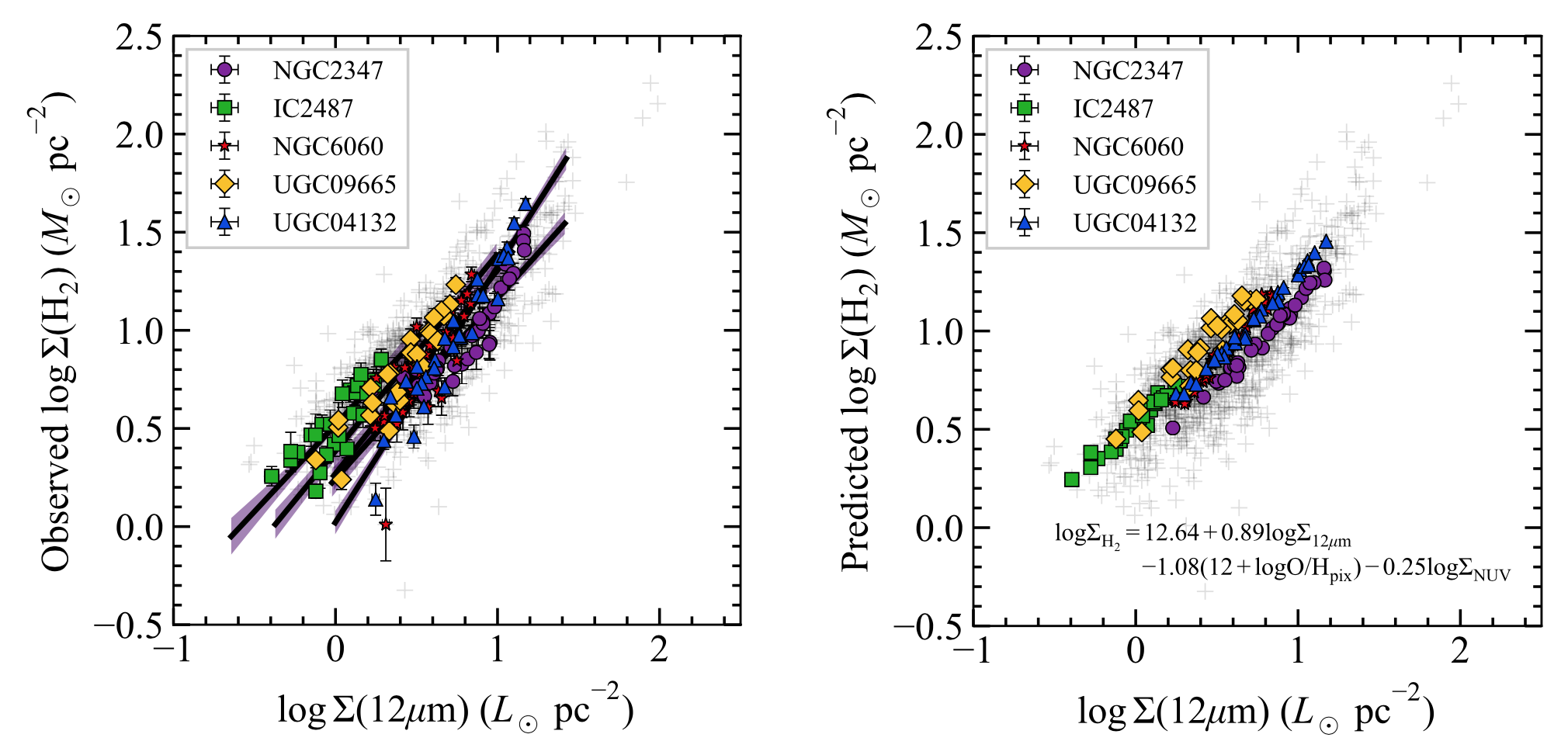A new estimator of resolved molecular gas in nearby galaxies
Stars form out of molecular hydrogen in cold, dense regions of the interstellar medium (ISM). Empirically this picture is supported by correlations between tracers of cold gas and the radiation output from young stars such as the Kennicutt-Schmidt (KS) law. One manifestation of the KS law is the correlation between 12 micron luminosity, measured with the Wide-field Infrared Survey Explorer (WISE; Wright et al. 2010), and CO luminosity measured by ground-based radio telescopes. The 12 micron band spans mid-infrared wavelengths of 8 to 16 microns. In nearby galaxies, 12 micron emission traces star-formation rate (SFR), vibrational emission lines from polycyclic aromatic hydrocarbons (PAHs), and warm dust emission. Galaxy-integrated 12 micron luminosity is strongly correlated with CO(1-0) and CO(2-1) luminosity in nearby galaxies (Jiang et al., 2015; Gao et al., 2019). This correlation is useful for predicting molecular gas masses in galaxies since 12 micron images already exist thanks to the WISE survey (which covers the full sky), whereas CO luminosities require dedicated observations.
It is not known whether the global 12um-CO correlation holds within galaxies. In a recent study, a collaboration led by Ryan Chown from MacMaster University and Prof. Cheng Li from DoA at Tsinghua University used spatially-resolved CO(1-0) data from the Extragalactic Database for Galaxy Evolution survey (EDGE; Bolatto et al., 2017) and WISE 12 micron images to measure the 12um-CO(1-0) correlation within individual galaxies (Chown et al. 2020). The 12um-CO correlation is found to be strong within galaxies, and the best-fit parameters for this relation vary significantly from galaxy to galaxy (Figure 1, left panel). They perform multivariate linear regression on 63 galaxies at ~kpc resolution, using a combination of global galaxy measurements and quantities derived from spatially resolved optical spectroscopy from the Calar Alto Legacy Integral Field Area Survey (CALIFA; Sanchez et al., 2016). This yields a set of linear functions with log H2 surface density as the independent variable, any of which can be used as spatially resolved estimators of H2 surface density. These estimators can predict H2 surface density with an RMS accuracy of ~0.2 dex per pixel in galaxies for which 12 micron data are available. An example application of one of the estimators is shown in Figure 2 (right panel). They also find that 12 micron surface density is a better predictor of H2 surface density than any other quantity considered. H2 and 12um are more tightly correlated than H2 and resolved SFR surface density, stellar mass surface density, visual extinction, and gas-phase metallicity from CALIFA, over the same set of pixels. The best-fit relation between H2 and 12um are shown in the title figure.
These estimators are expected to be useful for generating large samples of resolved H2 surface density in nearby galaxies. Looking forward, it will be exciting to study this correlation at higher resolution in more nearby galaxies using ALMA CO data, and, in the more distant future with higher resolution mid-infrared images from the James Webb Space Telescope. It remains to be determined exactly what is driving this strong correlation – how much of the emission is due to PAHs versus warm dust? Future studies with resolution-matched infrared data from Spitzer will likely be able to disentangle these components.
References:
Ryan Chown, Cheng Li, Laura Parker, Christine Wilson, Niu Li and Yang Gao, 2020, submitted to MNRAS, E-print available at https://arxiv.org/abs/2007.00174
Barrera-Ballesteros, et al., 2020, MNRAS, 492, 2651
Bolatto, et al., 2017, ApJ, 846, 159
Wright, et al., 2010, AJ, 140, 1868
Jiang, et al., 2015, ApJ, 799, 92
Gao, et al., 2019, ApJ, 887, 172
Yesuf, et al., 2019, ApJ, 884, 177
Sanchez, et al., 2016, A&A, 594, A36




